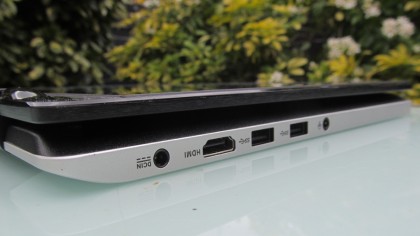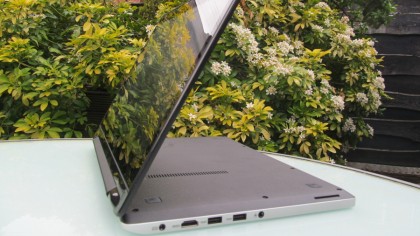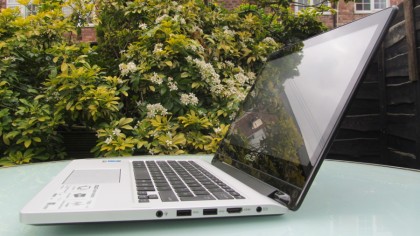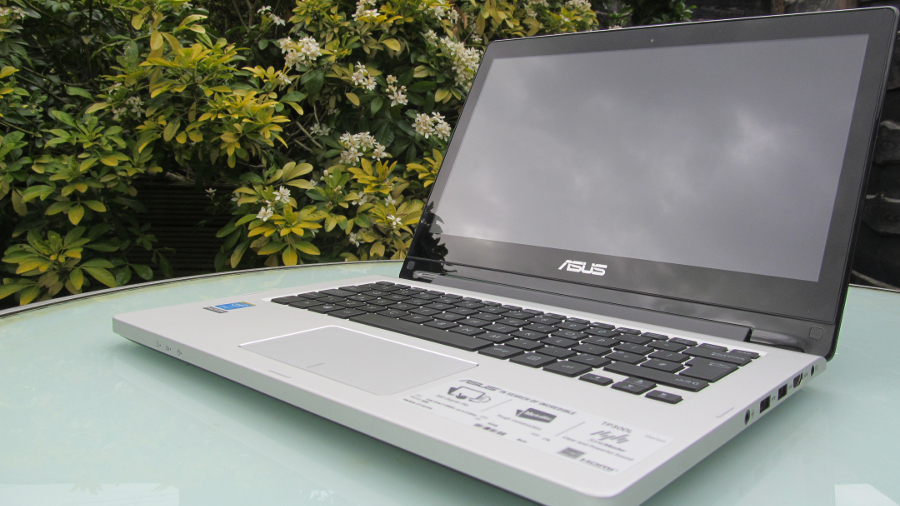Why you can trust TechRadar
Here is the Asus Transformer Book Flip TP300LA (model DW176H) spec sheet as provided to TechRadar:
- CPU: 2.4GHz Intel Core i7-5500U (dual-core, 4MB Cache, up to 3GHz with Turbo Boost)
- Graphics: Intel HD Graphics 5500
- RAM: 8GB DDR3
- Screen: 13.3-inches, 1366 x 768, Multitouch
- Storage: 1TB HDD 5400RPM
- Optical drive: No
- Ports: Combo audio jack, 2 x USB 3.0 ports, 1 x USB 2.0 port, HDMI, SD card reader
- Connectivity: Intel Dual-Band Wireless – AC 7260 + Bluetooth 4.0
- Camera: HD Webcam
- Weight: 3.96 pounds (1.8kg)
- Size: 0.86 x 12.9 x 8.86-inches, 22 x 329 x 225mm (H x W x D)
On the left side there's a power switch (which this particular reviewer missed for a while), Windows button (which comes into its own in tablet mode), USB 2.0 port, SD card slot and a Kensington lock, should you need it. The buttons themselves are shallow set and don't detract from the sleek design, although it's easy to get the Windows key and power button mixed up.

Also the volume rocker is upside down when in laptop mode, as it's designed to be used primarily in touchscreen mode – when the screen is flipped around it's the correct way up. It would be great if the FlipLock software switched the volume rocker depending on which mode the machine is in.
On the right side there's a headphone/microphone combo socket, two USB 3.0 ports, an HDMI port and the power inlet. They're set comfortably apart and housed in brushed aluminium. Across the front there's the standard on light, charging indicator and HD LED.
There really isn't much difference between the touch, feel and look of the black keyboard compared to a standard MacBook. The keys are responsive, spring back well and aren't too noisy. However there's no keyboard backlight, and this may be a slight annoyance to people who want to use the laptop in low light.
The touchpad is responsive and sleek with a shiny bezel, plus the left and right clickers work well. It's slightly sticky, but no more than any standard PC touchpad. However you do get the added bonus of being able to use the touchscreen at any time.
Hard drive
One of the most instantly noticeable things about this machine is the ticking hard drive. Unlike other non-solid state drives this one is incredibly noisy. It kept me awake while I was downloading Shadow of Mordor overnight, so much so I had to switch it off. Also the first model I was sent had a defective hard drive and had to be returned, though the second unit ran without any hard drive errors.
The lack of solid state means that on one hand this machine has a huge 1TB of space to load with movies, music and games, but on the other, booting isn't as fast as it could be and design work and gaming are bottlenecked by the chugging spinning disk. Of course in the age of cloud storage and streaming it could be argued that large hard drives are becoming surplus to requirements.

Weight, size and battery
At 3.96lb or 1.8kg it's heavier than a 14-inch Yoga 3 (3.75lbs) despite only being a 13.3-inch laptop. This is essentially a laptop with a touchscreen, and is probably too cumbersome to be a realistic tablet substitute.
Size-wise it's 0.86 x 12.9 x 8.86-inches, and while the rotating hinge isn't bulky, incorporating it has left the machine both heavier and slightly larger than a standard non-flipping laptop. Compared to the Yoga 3 which is 0.72 x 13.18 x 9.03-inches, the Asus is slightly thicker but its footprint is a little smaller. The extra thickness and weight does make it more difficult to hold than the Yoga when being used as a tablet.
The machine lasted just as long as a conventional laptop. The battery life didn't wow me but it also didn't disappoint. Playing games noticeably drained it faster, and it also meant the fan occasionally kicked into action, but this was never quite as loud as the hard drive.
Benchmarks
- 3DMark: Cloud Gate: 5715; Sky Diver: 2795; Fire Strike: 769
- Cinebench: CPU: 300 points; Graphics: 31.86 fps
- PCMark 8 Home Test: 2521 points
- PCMark 8 Battery Life: 4 hours 40 minutes
- Middle Earth: Shadow of Mordor (1366 x 768, V-Sync): 10-12 fps; (910 x 512, No V-Sync): 30-36 fps
- Metro: Last Light (1366 x 768, Very High, SSAA on, Texture Filtering AF16X, Motion Blur normal, SSAA 4X, Texture Filtering AF 16x, Motion Blur Normal, Tessellation High): 4-5 fps; (800 x 600, Low, SSAA off, Texture Filtering AF 4x, Motion Blur Low, Tessellation Off ): 11-13 fps
Screen, gaming and sound
The screen is a little dim and isn't viewable from all angles. Using it outside in bright sunshine isn't really possible. The touchscreen is very responsive, and doesn't feel like it's an add-on or poorly installed.
Both the rattling hard drive and graphics are a bottleneck to gamers, although Shadow of Mordor ran at a respectable 30 fps in the lowest resolution. It was pleasantly playable, but the slightly older Metro: Last Light ran at a sluggish 11-13 fps on the lowest setting. Some gaming is possible on this machine but it's probably best to test with demos to see what it can do. If you do want a gaming laptop, for around £150 more Asus has the N550JK gaming laptop which was released in late 2014.
It's the graphics processor – the Intel HD Graphics 5500 – which is more suited to watching films and browsing the web that drags the i7 processor down. But of course to get anything more powerful, you'll need to be paying more.
Audio isn't as crisp as it could be, but it's never distorted even at high volume. The stereo separation isn't very wide. You won't hear much difference in sound whether it's in tablet or laptop mode as the speakers are buried somewhere inside the hinge. It's loud enough to watch a film with a friend, just don't expect any earth-shattering bass or volume.

Bundled software
Asus bundles a variety of software on the machine varying from extremely useful to a bit pointless. Our favourites are the Smart Gesture and FlipLock – both make the everyday operation of the machine a lot easier, when they work.
Here's a quick rundown of what you get…
Asus Web Storage: 5GB of free web storage is always useful.
USB Charger +: This allows you to charge an MP3 player or phone while the computer is in sleep mode.
Asus Smart Gesture: A genuinely useful program that enables multi-touch gestures on the touchpad akin to those found in OS X. Windows doesn't really have a built-in equivalent.
Asus FlipLock: Great in theory, this disables the keyboard when in stand, tent or tablet mode – except it stopped working after a while and reinstalling it didn't solve the problem.
